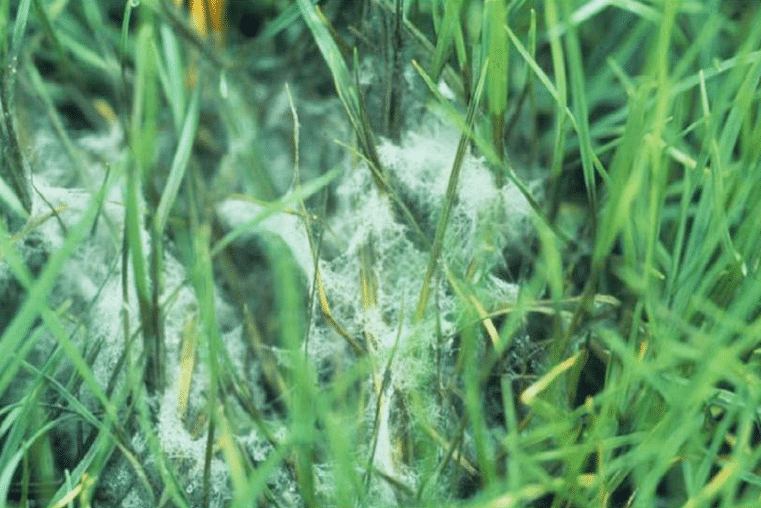
When your lawn is suddenly hit with a disease, you might not know how or where to begin when it comes to treating it. Learn how to identify and treat the five of the most common lawn diseases: brown patch, red thread, snow mold, summer patch, pythium, and rust.
How to Identify Lawn Diseases
The vast majority of lawn issues in the summer are drought related dormancy. If your lawn appears straw-like and brown in large, irregular patches, there's about a 50% chance that it's dormancy caused by heat and drought. If you're able to rule that out, however, then you have a potentially larger problem on your hands, and you'll want to quickly identify and start treating the disease.
Brown Patch
Brown patch is characterized by the large, circular patches that appear dead or dry, typically affecting your lawn during hot and humid weather. This disease can be exacerbated by patches of wet leaves on your lawn, high humidity, and over-fertilizing your lawn.

How to prevent:
- Irrigation Frequency: Brown patch spreads when grass blades stay wet for long periods. To avoid this, back off your irrigation frequency. Water your lawn no more than twice a week, and increase the time per watering session to ensure you're getting at least 1/4 to 1/2 an inch of water per session. Deep and infrequent should be the idea.
- Irrigation Schedule: Water just before sunrise, and try not to water at all in the afternoon. The idea is to allow the sunlight to dry out the lawn for as long as possible before nightfall.
Red Thread
Red thread thrives in cool and humid conditions and is identified by its red and thread-like strands or blades stemming from the grass. Under-fertilizing, high humidity, poor air circulation, excess shade, large amounts of thatch, wet leaves, and compacted soil lead to red thread. If left untreated, this disease can survive for a long period of time, making it more difficult to eradicate.

Summer Patch
As its name suggests, this lawn disease occurs in the summer, between June and September. Periods of high humidity, along with high temperatures, support the development of summer patch. Pair that with excessive soil moisture, compacted soil, poor drainage and mowing too low, and you might be in trouble! Summer patch is characterized by irregular brown patches and rings of dying, brown grass.

Rust
Rust lawn disease shows through weak, thinning grasses that transform into a rust color. It frequently occurs from early summer through fall, when mild to warm temperatures arise. Drought, high humidity, extended wetness, too much shade, and under-fertilizing all contribute to this disease. To identify rust (aside from color) try pulling on the leaf blades. If it comes right up without much effort, it's likely rust.

Pythium
Pythium appears as a cotton-like crystal within the leaf canopy. This is often confused with the dander from cottonwood trees. Symptoms will first appear as small, irregularly shaped spots that are 1/2" to 4" inches in diameter and will join to form large patches that will often be long streaks. The turfgrass leaves will at first look and feel water-soaked, greasy, and slimy. Once the moisture dries up the leaf blade will shrivel up and collapse, often causing a matted turf. It usually appears in humid, over-fertilized lawns. Once it appears it is particularly aggressive in it's spread, and can wipe out a lawn in a matter of days.

How to fix it:
- Remove dew during hot and humid weather. You can do this with a leaf blower, a lawnmower (bagging clippings in the affected area) or dragging a hose across the surface of the lawn.
- Avoid using a quick release, Nitrogen based fertilizer. Try instead to use a low Nitrogen or slow release Nitrogen fertilizer, especially during high humidity and temperatures.
Bonus - Snow Mold!
This one is not exactly a summer lawn disease, but it's important to recognize nonetheless, so save this one for early next season. This mold generally grows underneath snow cover but can also survive in cool, wet weather without snow. Over-fertilizing, poor drainage, and excess shade are often the culprits of snow mold. It’s identified by grayish or whitish patches of crusty grass and is noticeable when the snow begins to melt in early spring.

How to Treat Lawn Diseases, Generally
Although it might seem like the end of the world when a disease takes over your lawn, the good news is it can be fixed. Follow these easy steps to revive your beloved yard:
- Most disease is the result of high humidity and moisture content in the summer. Water your lawn in the early morning (between 4-8 AM) to allow plenty of time for it to dry during the day and prevent moisture build-up.
- Avoid watering your lawn on days when rain is in the forecast.
- Mow when your lawn is dry and bag the clippings to avoid spreading the disease to other sections of your lawn.
Do your research, understand the conditions of your lawn, and put in consistent effort, and take back your lawn!
Lawnbright’s customized lawn plans will help get your lawn back on the road to recovery!